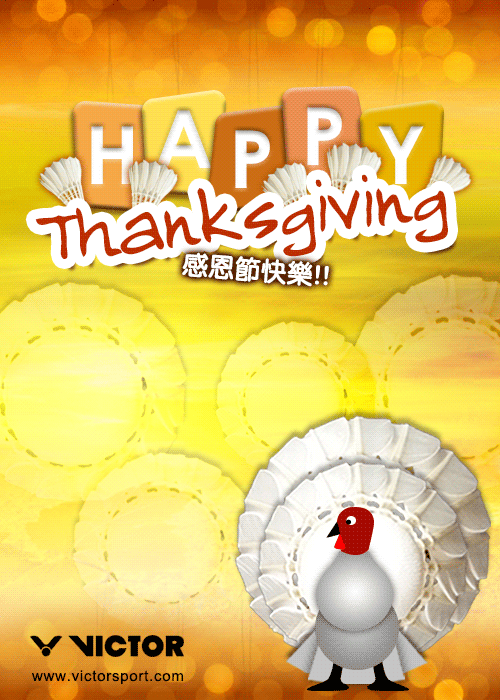
 |
|
2012 VICTOR E-card download:Happy Thanksgiving !! |
Thanksgiving Day is a national holiday celebrated primarily in the United States and Canada. Several other places around the world observe similar celebrations. It is celebrated on the fourth Thursday of November in the United States and on the second Monday of October in Canada. Thanksgiving has its historical roots in religious and cultural traditions, but today is celebrated in a more secular manner.
Some tips about Thanksgiving :
History
Prayers of thanks and special thanksgiving ceremonies are common among almost all religions after harvests and at other times.[1] The holiday's history in North America is rooted in English traditions dating from the Protestant Reformation. It also has aspects of a harvest festival, even though the harvest in New England occurs well before the late-November date of the holiday.
In the English tradition, days of thanksgiving and special thanksgiving religious services became important during the English Reformation in the reign of Henry VIII and in reaction to the large number of religious holidays on the Catholic calendar. Before 1536 there were 95 Church holidays, plus 52 Sundays, when people were required to attend church and forego work and sometimes pay for expensive celebrations. The 1536 reforms reduced the number of Church holidays to 27, but some Puritans, the radical reformers of their age, wished to completely eliminate all Church holidays, including Christmas and Easter.
The holidays were to be replaced by specially called Days of Fasting or Days of Thanksgiving, in response to events that the Puritans viewed as acts of special providence. Unexpected disasters or threats of judgement from on high called for Days of Fasting. Special blessings, viewed as coming from God, called for Days of Thanksgiving. For example, Days of Fasting were called on account of drought in 1611, floods in 1613, and plague in 1604 and 1622. Days of Thanksgiving were called following the victory over the Spanish Armada in 1588, and following the deliverance of Queen Anne in 1705. An unusual annual Day of Thanksgiving began in 1606 following the failure of the Gunpowder Plot in 1605, and developed into Guy Fawkes Day.
Fixing the date of the holiday
The reason for the earlier Thanksgiving celebrations in Canada has often been attributed to the earlier onset of winter in the north, thus ending the harvest season earlier.Thanksgiving in Canada did not have a fixed date until the late 19th century. Prior to Canadian Confederation, many of the individual colonial governors of the Canadian provinces had declared their own days of Thanksgiving. The first official Canadian Thanksgiving occurred on April 15, 1872, when the nation was celebrating the Prince of Wales' recovery from a serious illness.[22] By the end of the 19th century,
Thanksgiving Day was normally celebrated on November 6. However, when World War I ended, the Armistice Day holiday was usually held during the same week. To prevent the two holidays from clashing with one another, in 1957 the Canadian Parliament proclaimed Thanksgiving to be observed on its present date on the second Monday of October.[6] Since 1971, when the American Uniform Monday Holiday Act took effect, the American observance of Columbus Day has coincided with the Canadian observance of Thanksgiving.
Much like in Canada, Thanksgiving in the United States was observed on various dates throughout history. From the time of the Founding Fathers until the time of Lincoln, the date Thanksgiving was observed varied from state to state. The final Thursday in November had become the customary date in most U.S. states by the beginning of the 19th century. Thanksgiving was first celebrated on the same date by all states in 1863 by a presidential proclamation of Abraham Lincoln. Influenced by the campaigning of author Sarah Josepha Hale, who wrote letters to politicians for around 40 years trying to make it an official holiday, Lincoln proclaimed the date to be the final Thursday in November in an attempt to foster a sense of American unity between the Northern and Southern states.[25] Because of the ongoing Civil War and the Confederate States of America's refusal to recognize Lincoln's authority, a nationwide Thanksgiving date was not realized until Reconstruction was completed in the 1870s.
On December 26, 1941, President Franklin D. Roosevelt signed a joint resolution of Congress changing the national Thanksgiving Day from the last Thursday in November to the fourth Thursday. Two years earlier, Roosevelt had used a presidential proclamation to try to achieve this change, reasoning that earlier celebration of the holiday would give the country an economic boost.
Information from :Wikipedia









